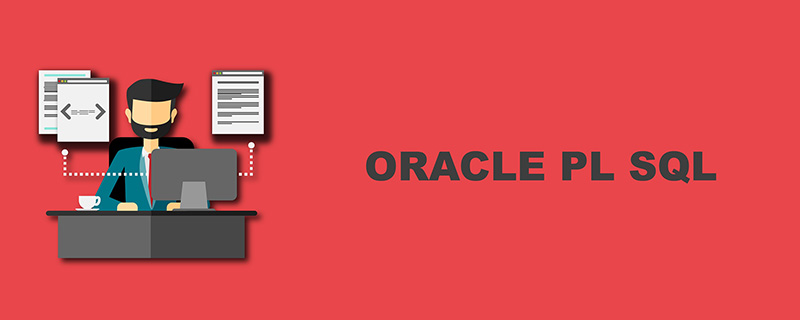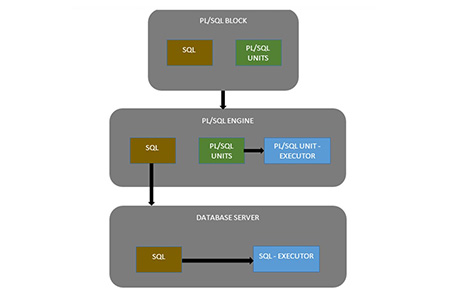What is PL/SQL? A brief introduction to PL/SQL
PL/SQL is an extension of Structured Query Language (SQL); unlike SQL, it allows programmers to write code in a procedural format. It combines the data processing capabilities of SQL with the processing capabilities of procedural languages to create super powerful SQL queries. The following article will introduce you to PL/SQL. I hope it will be helpful to everyone.

A brief introduction to PL/SQL
PL/SQL is a high-level structure ized and readable language. Its construction clearly expresses the intent of the code. Furthermore, PL/SQL is a straightforward language to learn.
PL/SQL is the standard and portable language for Oracle database development. If the program is executed on an Oracle database, it can be quickly moved to another compatible Oracle database without any changes.
PL/SQL is an embedded language. PL/SQL can only be executed in Oracle database, PL/SQL programs cannot be run on systems without Oracle database.
PL/SQL is a high-performance, highly integrated database language. In addition to PL/SQL, other programming languages such as Java, C#, and C can also be used. However, when interacting with Oracle databases, it is easier to write efficient code in PL/SQL than in other programming languages.
PL/SQL architecture
PL/SQL architecture mainly includes three components. Let’s take a brief look at them:
PL/SQL block structure
1. Block is the basic unit of programming in PL/SQL. It encapsulates a set of executable statements to complete the programmer's business needs. .
2. It includes different parts for logically dividing the code (declaration part for declaration purposes, execution part for processing statements, exception handling part for handling errors).
3. It also contains SQL instructions for interacting with the database server.
4. All PL/SQL units are considered as PL/SQL blocks, which is the initial stage of the architecture as the main input.
PL/SQL engine
1. The PL/SQL engine is the component that performs actual code processing.
2. It is responsible for compiling PL/SQL code into bytecode and executing executable code;
3. It can be installed in database servers and application servers.
4. The PL/SQL engine separates the PL/SQL unit and the SQL part in the input; the separated PL/SQL unit will be processed by the PL/SQL engine itself.
5. It will send the SQL part to the database server, where the actual interaction with the database occurs.
Note: The PL/SQL engine can only be installed in application development tools such as Oracle database server or Oracle Forms.
Database Server
1. The database server is the most important component in the Pl/SQL unit that stores data;
2. It is executed by SQL It consists of a processor that parses the input SQL statement and performs the same operation.
3. The PL/SQL engine uses SQL in the PL/SQL unit to interact with the database server.
Below is a graphical representation of the PL/SQL architecture.

Characteristics of PL/SQL
1. By executing SQL statements in batches Provides high performance not individually, thus avoiding call overhead.
2. Create complex business logic into a single program unit, thereby promoting encapsulation and productivity.
3. Integrate SQL very tightly, thereby reducing maintenance and complexity.
4. Complete portability - PL/SQL code written in one operating system can be successfully migrated to another operating system running Oracle.
5. Support high security through the encryption and decryption logic provided by Oracle's built-in software package.
6. Interaction with other programming languages.
7. Applications written in PL/SQL can be transplanted on any platform that supports Oracle.
8. Context switching overhead can be avoided by using advanced PL/SQL concepts such as batch collection and FORALL.
9. Implement object-oriented programming concepts, such as overloading.
The above is the entire content of this article, I hope it will be helpful to everyone's study. For more exciting content, you can pay attention to the relevant tutorial columns of the PHP Chinese website! ! !
The above is the detailed content of What is PL/SQL? A brief introduction to PL/SQL. For more information, please follow other related articles on the PHP Chinese website!

Hot AI Tools

Undresser.AI Undress
AI-powered app for creating realistic nude photos

AI Clothes Remover
Online AI tool for removing clothes from photos.

Undress AI Tool
Undress images for free

Clothoff.io
AI clothes remover

Video Face Swap
Swap faces in any video effortlessly with our completely free AI face swap tool!

Hot Article

Hot Tools

Notepad++7.3.1
Easy-to-use and free code editor

SublimeText3 Chinese version
Chinese version, very easy to use

Zend Studio 13.0.1
Powerful PHP integrated development environment

Dreamweaver CS6
Visual web development tools

SublimeText3 Mac version
God-level code editing software (SublimeText3)

Hot Topics
 1665
1665
 14
14
 1424
1424
 52
52
 1321
1321
 25
25
 1269
1269
 29
29
 1249
1249
 24
24
 iOS 18 adds a new 'Recovered' album function to retrieve lost or damaged photos
Jul 18, 2024 am 05:48 AM
iOS 18 adds a new 'Recovered' album function to retrieve lost or damaged photos
Jul 18, 2024 am 05:48 AM
Apple's latest releases of iOS18, iPadOS18 and macOS Sequoia systems have added an important feature to the Photos application, designed to help users easily recover photos and videos lost or damaged due to various reasons. The new feature introduces an album called "Recovered" in the Tools section of the Photos app that will automatically appear when a user has pictures or videos on their device that are not part of their photo library. The emergence of the "Recovered" album provides a solution for photos and videos lost due to database corruption, the camera application not saving to the photo library correctly, or a third-party application managing the photo library. Users only need a few simple steps
 How to handle database connection errors in PHP
Jun 05, 2024 pm 02:16 PM
How to handle database connection errors in PHP
Jun 05, 2024 pm 02:16 PM
To handle database connection errors in PHP, you can use the following steps: Use mysqli_connect_errno() to obtain the error code. Use mysqli_connect_error() to get the error message. By capturing and logging these error messages, database connection issues can be easily identified and resolved, ensuring the smooth running of your application.
 Detailed tutorial on establishing a database connection using MySQLi in PHP
Jun 04, 2024 pm 01:42 PM
Detailed tutorial on establishing a database connection using MySQLi in PHP
Jun 04, 2024 pm 01:42 PM
How to use MySQLi to establish a database connection in PHP: Include MySQLi extension (require_once) Create connection function (functionconnect_to_db) Call connection function ($conn=connect_to_db()) Execute query ($result=$conn->query()) Close connection ( $conn->close())
 How to save JSON data to database in Golang?
Jun 06, 2024 am 11:24 AM
How to save JSON data to database in Golang?
Jun 06, 2024 am 11:24 AM
JSON data can be saved into a MySQL database by using the gjson library or the json.Unmarshal function. The gjson library provides convenience methods to parse JSON fields, and the json.Unmarshal function requires a target type pointer to unmarshal JSON data. Both methods require preparing SQL statements and performing insert operations to persist the data into the database.
 How to use database callback functions in Golang?
Jun 03, 2024 pm 02:20 PM
How to use database callback functions in Golang?
Jun 03, 2024 pm 02:20 PM
Using the database callback function in Golang can achieve: executing custom code after the specified database operation is completed. Add custom behavior through separate functions without writing additional code. Callback functions are available for insert, update, delete, and query operations. You must use the sql.Exec, sql.QueryRow, or sql.Query function to use the callback function.
 MySQL: Simple Concepts for Easy Learning
Apr 10, 2025 am 09:29 AM
MySQL: Simple Concepts for Easy Learning
Apr 10, 2025 am 09:29 AM
MySQL is an open source relational database management system. 1) Create database and tables: Use the CREATEDATABASE and CREATETABLE commands. 2) Basic operations: INSERT, UPDATE, DELETE and SELECT. 3) Advanced operations: JOIN, subquery and transaction processing. 4) Debugging skills: Check syntax, data type and permissions. 5) Optimization suggestions: Use indexes, avoid SELECT* and use transactions.
 PHP Database Connection Pitfalls: Avoid Common Mistakes and Misunderstandings
Jun 05, 2024 pm 10:21 PM
PHP Database Connection Pitfalls: Avoid Common Mistakes and Misunderstandings
Jun 05, 2024 pm 10:21 PM
To avoid PHP database connection errors, follow best practices: check for connection errors and match variable names with credentials. Use secure storage or environment variables to avoid hardcoding credentials. Close the connection after use to prevent SQL injection and use prepared statements or bound parameters.
 MySQL: An Introduction to the World's Most Popular Database
Apr 12, 2025 am 12:18 AM
MySQL: An Introduction to the World's Most Popular Database
Apr 12, 2025 am 12:18 AM
MySQL is an open source relational database management system, mainly used to store and retrieve data quickly and reliably. Its working principle includes client requests, query resolution, execution of queries and return results. Examples of usage include creating tables, inserting and querying data, and advanced features such as JOIN operations. Common errors involve SQL syntax, data types, and permissions, and optimization suggestions include the use of indexes, optimized queries, and partitioning of tables.




